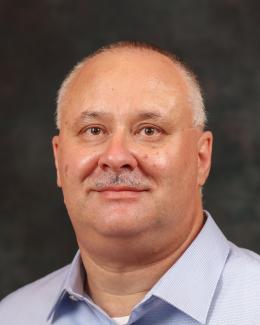Oak Ridge National Laboratory, Pacific Northwest National Laboratory and Washington State University turn to fundamental chemistry to advance cleanup strategies for legacy tank waste. Pictured, ORNL collaborator Hsiu-Wen Wang led the neutron scattering experiments at the Spallation Neutron Source to probe complex electrolyte solutions that challenge nuclear waste processing at Hanford and other sites. Credit: Genevieve Martin/Oak Ridge National Laboratory, U.S. Dept. of Energy.
Researchers at the Department of Energy’s Oak Ridge National Laboratory, Pacific Northwest National Laboratory and Washington State University teamed up to investigate the complex dynamics of low-water liquids that challenge nuclear waste processing at federal cleanup sites.
The results, featured as a cover in the Journal of Physical Chemistry B, help shed light on the fundamental chemistry at work in legacy tank waste, which is especially difficult to process because of the presence of unpredictable low-water or “water-in-salt” solutions.
“Remarkably, these electrolyte solutions are able to maintain a liquid state at very high salt concentrations; but as a result, they do not move freely like normal, more dilute liquids,” said ORNL geochemist Hsiu-Wen Wang, who led the neutron scattering research performed in the study.
Water-in-salt solutions are characterized by high viscosities that can fluctuate between liquid and near-solid, glass-like states, making them difficult to control. In nuclear waste tanks, these caustic solutions can clog pumps and pipes, hindering their removal for processing.
A better understanding of the fundamental chemistry of this unusual class of liquids could support broad applications for stabilizing these solutions and inform cleanup strategies for legacy tank waste accumulated during the 1940s–1980s.
DOE’s Hanford Site in Washington, for example, generated billions of gallons of contaminated liquids during more than 40 years of its Atomic-era operations. The site’s “tank farms” are one of the most difficult and costly agenda items on DOE’s environmental cleanup program.
“Remediation of the waste is complicated by the unique chemical properties in this type of complex, highly concentrated environment, with radioactivity creating additional challenges,” said Andrew Stack of ORNL’s Chemical Sciences Division. “By working to understand what is happening on an atomic level in complex solutions, we can better predict their properties and their reactivity, and that may lead to improved strategies to process nuclear waste.”
Supported by IDREAM (Interfacial Dynamics in Radioactive Environments and Materials), a DOE Energy Frontier Research Center, researchers studied a nonradioactive synthetic brine of sodium-hydroxide-aluminate (Na+OH–/Al(OH)4–).
The mixture is present in more dilute concentrations in Hanford’s waste tanks, along with several other electrolyte solutions that behave similarly.
In a glass of water at room temperature, water molecules migrate in picoseconds. However, in the solutions studied, researchers found these motions to be 10 to 100 times slower, depending on the salt concentration.
Essentially, water molecules are “trapped” or surrounded by ions in a complex soup of interconnected motions. “For one ion to move, a lot of other molecules and ions have to move, which makes the dynamics interesting,” said Wang.
Despite the sluggish nature of water-in-salt solutions, said Stack, “many different types of simultaneous motions—some fast and some slow—are taking place at the atomic level.”
To understand these fast-and-slow atomic motions, researchers turned to experimental capabilities at two DOE Office of Science User Facilities, the Spallation Neutron Source at ORNL and the Environmental Molecular Sciences Laboratory at PNNL.
The team conducted quasi-elastic neutron scattering (QENS) at ORNL and nuclear magnetic resonance (NMR) spectroscopy at PNNL. Used together, QENS and NMR spectroscopy can provide alternate perspectives on the way atoms reorient and spread throughout a solution.
“NMR spectroscopy reveals the movement of atoms over many milliseconds, while QENS captures atomic motion over picoseconds,” said Trent Graham, who performed the NMR spectroscopy in the study. “In combination, these two techniques provide complementary data at multiple time scales, which is critical to understanding the complex motions of ions in the solutions we are studying.”
With the BASIS instrument at ORNL, the team used neutrons to collect unique information not obtainable by other techniques.
“Neutrons are well suited to water-based systems analysis, since they provide a favorable contrast for weak atoms, like hydrogen, not easily seen by X-rays; and QENS is a specific technique involving the use of neutrons to correlate spatial and temporal information about atoms,” said BASIS instrument scientist Eugene Mamontov.
“Atoms change positions as water moves, and QENS can tell you not only the rate or how quickly the jumps occur but also at what distance and how these details correspond to the chemical structure,” said Mamontov.
Combining dynamics with structural analysis is a goal of the research. Experimental data were compared with molecular dynamics simulations performed at the Oak Ridge Leadership Computing Facility, a DOE User Facility at ORNL, in a companion study on the structure of Na+OH–/Al(OH)4–.
The journal article is published as “Coupled Multimodal Dynamics of Hydrogen-Containing Ion Networks in Water-Deficient, Sodium Hydroxide-Aluminate Solutions.”
The DOE Office of Science supported the research.
UT-Battelle manages ORNL for the DOE Office of Science. The single largest supporter of basic research in the physical sciences in the United States, the Office of Science is working to address some of the most pressing challenges of our time. For more information, please visit energy.gov/science.




